- Mount Kangchenjunga – 8,598m
- Mount Nanda Devi – 7,816m
- Mount Kamet – 7,756m
- Saltoro Kangri/K10 – 7,742m
- Saser Kangri I/K22 – 7,672m
- Mamostong Kangri/K35 – 7,516m
- Saser Kangri II E – 7,513m
- Saser Kangri III – 7,495m
- Teram Kangri I – 7,462m
- Jongsong Peak – 7,462m
1. Mount Kangchenjunga – 8,598m
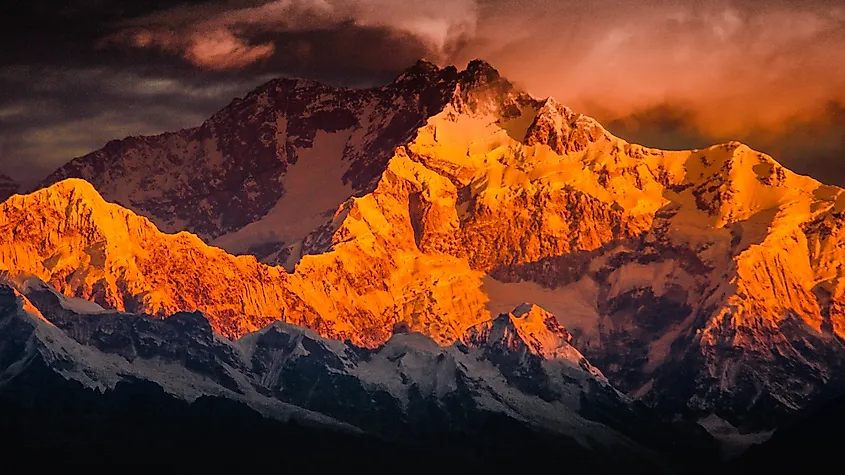
Mount Kangchenjunga which rises to an elevation of 8,598m is the highest mountain peak in India and the third highest mountain peak in the world. It is located in the Kangchenjunga Himal section of the massive Himalayan Mountain Range, along the boundary between India and Nepal. The name Kangchenjunga has been derived from a Tibetan word that means “the five treasures of the high snow”. Three of Kangchenjunga’s five main peaks are situated in the boundary between the Indian State of Sikkim and the eastern part of Nepal, while the remaining two peaks are situated in the Taplejung District of Nepal.
Since ancient times, Mount Kangchenjunga has been revered by the people of the State of Sikkim and the Darjeeling district of the State of West Bengal. Therefore, any act of climbing the summit of Kangchenjunga was considered as a disrespect to the religious beliefs of these people. On May 25, 1955, two English mountaineers Joe Brown and George Band became the first climbers to successfully climb Mount Kangchenjunga. However, as per their promise to the Chogyal, they did not complete their ascent to the summit and stopped their climb at a short distance before reaching the summit. Many protected areas including the Kangchenjunga Conservation Area in Nepal, Khangchendzonga National Park, Pangolakha Wildlife Sanctuary in Sikkim, Singalila National Park, and Neora Valley National Park in Darjeeling, etc have been established to protect and conserve the unique Kangchenjunga ecosystem.
2. Mount Nanda Devi – 7,816m
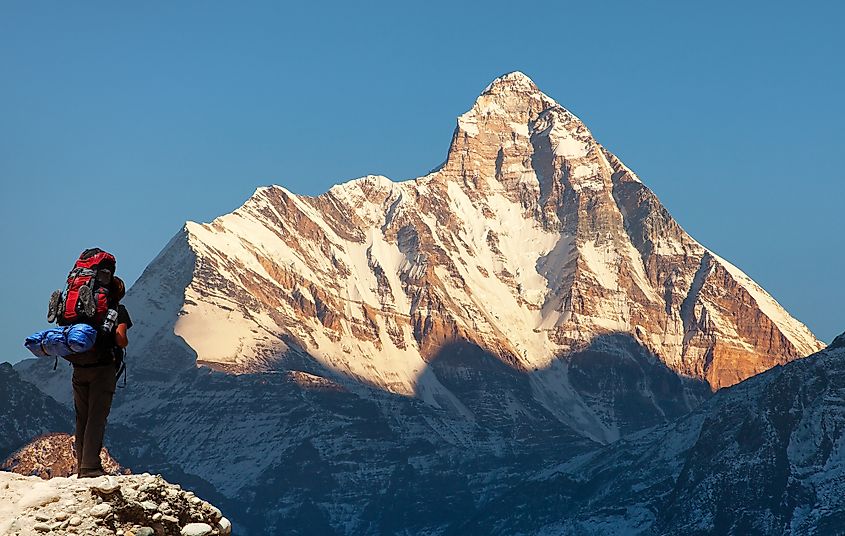
Mount Nanda Devi which rises to an elevation of 7,816m is the second highest mountain peak in India and the highest mountain situated entirely within the country. It is located in the Chamoli Garhwal district of the Indian state of Uttarakhand and is also considered the world’s 23rd highest mountain. Nanda Devi forms a part of the Garhwal Himalayas and has two peaks – the higher western and the shorter eastern summits. These two peaks are often referred to as the peaks of the Goddesses Sunanda and Nanda and are revered as sacred by the Garhwal and the Kumaon people. The snowmelt and glaciers of the mountain feed several rivers and streams including the Rishiganga, Pindar, and Dhauliganga rivers.
On August 29, 1936, two British mountaineers Noel Odell and Bill Tilman became the first climbers to climb Mount Nanda Devi, making it the highest peak to be successfully climbed by any human. To protect the mountain’s fragile ecosystem, the Government of India established the Nanda Devi Biosphere Reserve in 1982. The surrounding Nanda Devi National Park was designated as a World Heritage Site by UNESCO in 1988 due to its cultural and natural significance.
3. Mount Kamet – 7,756m
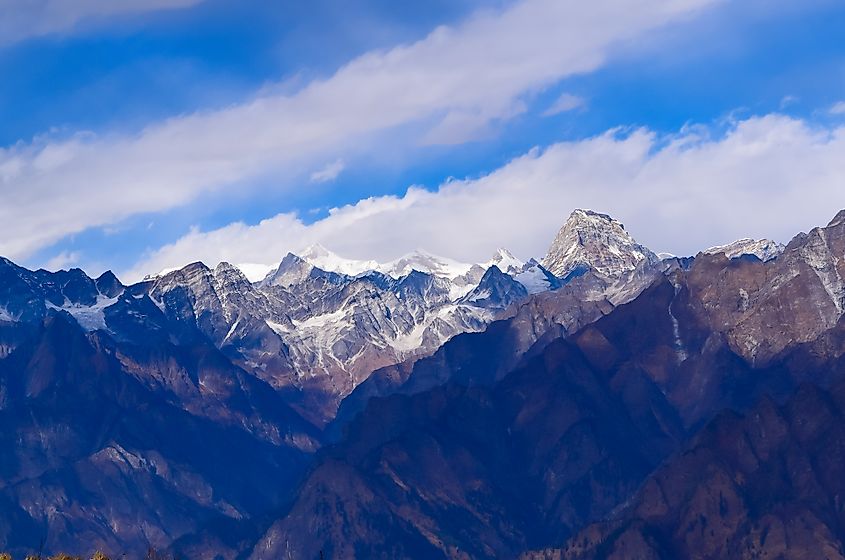
Mount Kamet which rises to an elevation of 7,756m is the third highest mountain peak in India and the world’s 29th highest mountain. After Nanda Devi, it is the second-highest mountain peak that is located in the Garhwal Himalayas in the Chamoli District of the Indian State of Uttarakhand. This mountain peak is surrounded by three other major neighboring peaks and is located close to the Tibetan Plateau. The mountain is home to several glaciers and rivers. On June 21, 1931, the English mountaineers Frank Smythe, Eric Shipton, R. L. Holdsworth, and Lewa Sherpa became the first climbers to climb Mount Kamet. Till the first ascent of Nanda Devi, Mount Kamet held the record of being the first Himalayan summit of more than 7,620m that was climbed by humans. Due to its remote location, the mountain is less accessible than other Himalayan peaks.
4. Saltoro Kangri/K10 – 7,742m
Mount Saltoro Kangri which rises to an elevation of 7,742m is the fourth highest mountain peak in India and the world’s 31st highest mountain. It is the highest peak of the Saltoro Mountain range, a sub-range of the Karakoram mountains. The mountain is situated on the Actual Ground Position Line between the Indian territory in the Siachen region and the Pakistani territory in the western part of the Saltoro Range. On July 24, 1962, the Japanese mountaineers Y. Takamura and A. Saito and the Pakistani climber R. A. Bashir became the first persons to climb Mount Saltoro Kangri. The mountain has been a source of territorial disputes between India and Pakistan and is therefore not highly visited by tourists mainly due to inaccessibility and military activities.
5. Saser Kangri I/K22 – 7,672m
Mount Saser Kangri I which rises to an elevation of 7,672m is the fifth highest mountain peak in India and the world’s 35th highest mountain. Situated within the Indian Union Territory of Ladakh, Mount Saser Kangri I is the highest peak of the Saser Muztagh, which is the easternmost subrange of the Karakoram mountains. On June 5, 1973, the climbers Dawa Norbu, Da Tenzing, Nima Tenzing, and Thondup became the first persons to climb Mount Saser Kangri I.
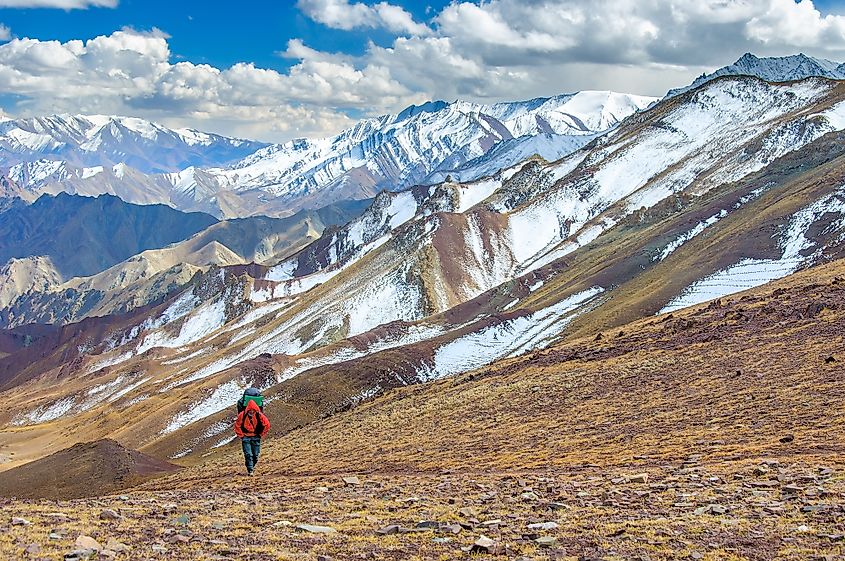
6. Mamostong Kangri/K35 – 7,516m
Mount Mamostong Kangri which rises to an elevation of 7,516m is the sixth highest mountain peak in India and the world’s 48th highest mountain. Situated in the Indian Union Territory of Ladakh close to the Indo-China border, Mount Mamostong Kangri is the highest peak of the remote Rimo Muztagh, a subrange of the Karakoram mountains. On September 13, 1984, the first ascent of the mountain was made by an Indo-Japanese expedition.
7. Saser Kangri II E – 7,513m
Mount Saser Kangri II E which rises to an elevation of 7,513m is the seventh highest mountain peak in India and the world’s 49th highest mountain. Situated within the Indian Union Territory of Ladakh, Mount Saser Kangri II E is one of the high peaks of Saser Muztagh, which is the easternmost subrange of the Karakoram mountains.
8. Saser Kangri III – 7,495m
Mount Saser Kangri III which rises to an elevation of 7,495m is the eighth highest mountain peak in India and the world’s 51st highest mountain. Situated within the Indian Union Territory of Ladakh, Mount Saser Kangri III is one of the high peaks of Saser Muztagh, which is the easternmost subrange of the Karakoram mountains.
9. Teram Kangri I – 7,462m
Mount Teram Kangri I which rises to an elevation of 7,462m is the ninth highest mountain peak in India and the world’s 56th highest mountain. Mount Teram Kangri I is the highest peak of the Teram Kangri group and of the remote Siachen Muztagh which is a subrange of the Karakoram Mountains. The mountain peak is situated on the border between the People’s Republic of China and the disputed Siachen Glacier region, close to the Line of Control between India and Pakistan. The northeastern side of the mountain peak lies in the China-controlled territory while its southwestern side is located in the Siachen area that is currently under Indian control. On August 10, 1975, some members of a Japanese expedition made the first ascent of Mount Teram Kangri I.
10. Jongsong Peak – 7,462m
The Jongsong Peak which rises to an elevation of 7,462m is the tenth highest peak in India and the world’s 57th highest mountain. It is located in the Janak section of the massive Himalayan Mountain Range, and its summit is situated on the tripoint of Nepal, India, and China. On June 2, 1930, the Jongsong Peak was first climbed by some members of a German expedition. Till the first ascent of Mount Kamet, Mount Jongsong held the record of being the world’s highest climbed mountain peak.
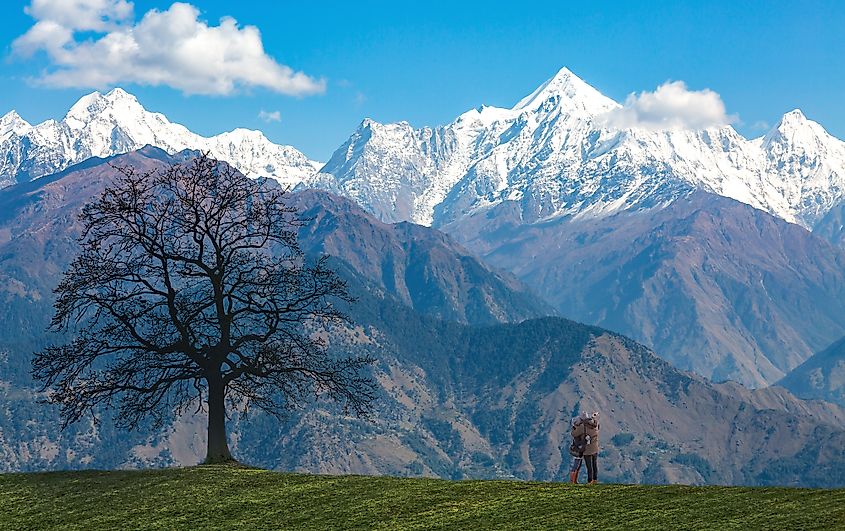
As seen in the above discussion, most of these mountains form a part of the massive Himalayan Mountain Range and are revered as ‘sacred’ by the country’s religious communities. These mountains also have immense economic value as their unique flora and fauna as well as the immense natural beauty attracts a large number of tourists supporting a growing tourism industry. However, the mountains have been greatly affected by climate change in recent decades. Higher temperatures have triggered the melting of glaciers on these mountains, adversely affecting the region’s hydrology patterns.
| Rank (India) | Name | Height (m) | Range | State |
| 1 | Kanchenjunga | 8,598 | Himalayas | Sikkim |
| 2 | Nanda Devi | 7,816 | Himalayas | Uttarakhand |
| 3 | Kamet | 7,756 | Himalayas | Uttarakhand |
| 4 | Saltoro Kangri / K10 | 7,742 | Saltoro Karakoram | Ladakh |
| 5 | Saser Kangri I / K22 | 7,672 | Saser Karakoram | Ladakh |
| 6 | Mamostong Kangri / K35 | 7,516 | Rimo Karakoram | Ladakh |
| 7 | Saser Kangri II E | 7,513 | Saser Karakoram | Ladakh |
| 8 | Saser Kangri III | 7,495 | Saser Karakoram | Ladakh |
| 9 | Teram Kangri I | 7,462 | Siachen Karakoram | Ladakh |
| 10 | Jongsong Peak | 7,462 | Kangchenjunga Himalaya | Sikkim |
| 11 | K12 | 7,428 | Saltoro Karakoram | Ladakh |
| 12 | Kabru N | 7,412 | Kangchenjunga Himalaya | Sikkim |
| 13 | Ghent Kangri | 7,401 | Saltoro Karakoram | Ladakh |
| 14 | Rimo I | 7,385 | Rimo Karakoram | Ladakh |
| 15 | Teram Kangri III | 7,382 | Siachen Karakoram | Ladakh |
| 16 | Kirat Chuli | 7,362 | Kangchenjunga Himalaya | Sikkim |
| 17 | Mana Peak | 7,272 | Garhwal Himalaya | Uttarakhand |
| 18 | Apsarasas Kangri | 7,245 | Siachen Karakoram | Ladakh |
| 19 | Mukut Parbat | 7,242 | Garhwal Himalaya | Uttarakhand |
| 20 | Rimo III | 7,233 | Rimo Karakoram | Ladakh |
| 21 | Singhi Kangri | 7,202 | Siachen Karakoram | Ladakh |
| 22 | Hardeol | 7,161 | Kumaon
Himalaya |
Uttarakhand |
| 23 | Chaukhamba I / Badrinath Peak | 7,138 | Garhwal Himalaya | Uttarakhand |
| 24 | Nun-Kun | 7,135 | Zanskar Himalaya | Ladakh |
| 25 | Pauhunri | 7,128 | Sikkim Himalaya | Sikkim |
| 26 | Pathibhara / The Pyramid | 7,123 | Kangchenjunga Himalaya | Sikkim |
| 27 | Trisul I | 7,120 | Kumaon Himalaya | Uttarakhand |
| 28 | Satopanth | 7,075 | Garhwal Himalaya | Uttarakhand |
| 29 | Tirsuli | 7,074 | Garhwal Himalaya | Uttarakhand |
| 30 | Chong Kumdang Ri | 7,071 | Rimo Karakoram | Ladakh |
| 31 | Dunagiri | 7,066 | Garhwal Himalaya | Uttarakhand |
| 32 | Kangto | 7,060 | Assam Himalaya | Arunachal Pradesh |
| 33 | Nyegyi Kansang | 7,047 | Assam Himalaya | Arunachal Pradesh |
| 34 | Padmanabh | 7,030 | Rimo Karakoram | Ladakh |
| 35 | Shudu Tsempa | 7,024 | Sikkim Himalaya | Sikkim |
| 36 | Chamshen Kangri / Tughmo Zarpo | 7,017 | Saser Karakoram | Ladakh |
| 37 | Aq Tash | 7,016 | Rimo Karakoram | Ladakh |
| 38 | Chong Kumdang Ri II | 7,004 | Rimo Karakoram | Ladakh |
| 39 | Rishi Pahar | 6,992 | Kumaon Himalaya | Uttarakhand |
| 40 | Thalay Sagar | 6,984 | Garhwal Himalaya | Uttarakhand |
| 41 | Mount Lakshmi | 6,983 | Rimo Karakoram | Ladakh |
| 42 | Kedarnath Main | 6,968 | Garhwal Himalaya | Uttarakhand |
| 43 | Langpo | 6,965 | Sikkim Himalaya | Sikkim |
| 44 | Saraswati Parvat I / Saraswati Peak | 6,940 | Garhwal Himalaya | Uttarakhand |
| 45 | Shahi Kangri | 6,934 | Central Tibetan Plateau | Ladakh |
| 46 | Sri Kailash | 6,932 | Garhwal Himalaya | Uttarakhand |
| 47 | Kalanka | 6,931 | Garhwal Himalaya | Uttarakhand |
| 48 | Chorten Nyima Ri | 6,927 | Sikkim Himalaya | Sikkim |
| 49 | Saf Minal / P. 6911 | 6,911 | Garhwal Himalaya | Uttarakhand |
| 50 | Panchchuli II | 6,904 | Kumaon
Himalaya |
Uttarakhand |


 Users Today : 504
Users Today : 504 Total views : 470290
Total views : 470290